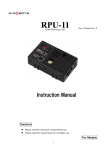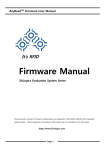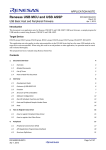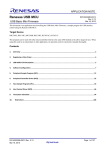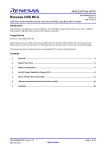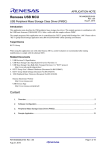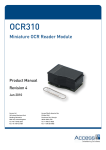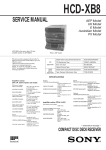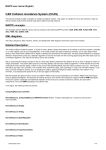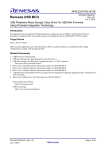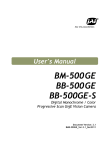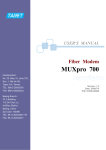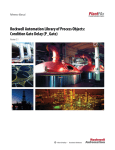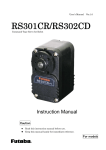Download USB Peripheral Communications Device Class Driver
Transcript
APPLICATION NOTE
Renesas USB MCU
R01AN0555EJ0213
Rev.2.13
Mar 16, 2015
USB Peripheral Communications Device Class Driver (PCDC) using USB Basic Mini Firmware
Introduction
This document is an application note describing use of the USB Peripheral Communications Device Class Driver
(PCDC) built using the USB Basic Mini Firmware.
Target Device
RL78/G1C, RL78/L1C, R8C/34U, R8C/3MK, R8C/34K
This program can be used with other microcontrollers that have the same USB module as the above target devices.
When using this code in an end product or other application, its operation must be tested and evaluated thoroughly.
This program has been evaluated using the corresponding MCU’s Renesas Starter Kit board.
Contents
1.
Overview ................................................................................................................................................... 2
2.
How to Register Class Driver ..................................................................................................................... 4
3.
Software Configuration ............................................................................................................................. 4
4.
Peripheral CDC Sample Application (APL) .................................................................................................. 7
5.
Communications Device Class (CDC) ........................................................................................................ 18
6.
USB Peripheral Communication Device Class Driver (PCDC) .................................................................... 23
7.
Communication Port Driver (CPD) ........................................................................................................... 30
R01AN0555EJ0213 Rev.2.13
Mar 16, 2015
Page 1 of 31
Renesas
1.
USB Peripheral Communications Device Class Driver (PCDC)
Overview
This document is an application note describing use of the USB peripheral Communication Device Class driver (PCDC)
and communication port driver sample driver, using the USB Basic Mini FirmwareRenesas.
The ACM subclass of the CDC class is used. For USB applications that need bulk transfer - large amounts of non time
critical data, this can be the most straightforward solution, since it can be used together with a PC UART terminal
program. These host–side COM port terminal applications most often have a file transfer menu options built in. The
terminal program will be opened towards the USB COM-port that will appear after enumeration.
1.1
Functions and Features
The PCDC conforms to the Abstract Control Model of the Communication Device Class specification (CDC) and
enables communication with a USB Host.
This class driver is intended to be used in combination with the USB Basic Mini Firmware from Renesas Electronics.
1.2
Related Documents
1. Universal Serial Bus Revision 2.0 specification
2. USB Class Definitions for Communications Devices Revision 1.2
3. USB Communications Class Subclass Specification for PSTN Devices Revision 1.2
[http://www.usb.org/developers/docs/]
4. User’s Manual: Hardware
5. USB Basic Mini Firmware Application Note (Document No. R01AN0326EJ)
6. USB Peripheral Communications Device Class Driver (PCDC) Installation Guide for Basic Mini Firmware
7. FIT SCI Asynchronous Mode Module Application Note (Document No. R01AN1667EU)
Available from Renesas Electronics WebSite
Renesas Electronics Website
[http:// www.renesas.com]
USB Devices Page
[http://www.renesas.com/prod/usb]
R01AN0555EJ0213 Rev.2.13
Mar 16, 2015
Page 2 of 31
Renesas
1.3
USB Peripheral Communications Device Class Driver (PCDC)
Terms and Abbreviations
Terms and abbreviations used in this document are listed below.
API
APL
CDC
CDCC
CDCD
CPD
cstd
Data Transfer
H/W
PCD
PCDC
PCDCD
PP
pstd
RSK
Scheduler
Scheduler Macro
SCI
SW1/SW2/SW3
Task
USB
USB-BASIC-F/W
1.4
:
:
:
:
:
:
:
:
:
:
:
:
:
:
:
:
:
:
:
:
:
:
Application Program Interface
Application program
Communications Devices Class
Communications Devices Class Communications Interface Class
Communications Devices Class Data Class Interface
Serial Communication Port Driver
Prefix of function and file for Host & Peripheral USB-BASIC-F/W
Generic name of Control transfer, Bulk transfer and Interrupt transfer
Renesas USB device
Peripheral control driver of USB-BASIC-F/W
Communications Devices Class for peripheral
Peripheral Communications Devices Class Driver
Pre-processed definition
Prefix of function and file for Peripheral USB-BASIC-F/W
Renesas Starter Kit
Used to schedule functions, like a simplified OS.
Used to call a scheduler function
Serial Communication Interface
Switch implemented on RSK board
Processing unit
Universal Serial Bus
USB Basic Mini Firmware for Renesas USB device
How to Read This Document
This document is not intended for reading straight through. Use it first to gain acquaintance with the package, then to
look up information on functionality and interfaces as needed for your particular solution.
Chapter 4 explains how the sample application works. You will change this to create your own solution.
Understand how all code modules are divided into tasks, and that these tasks pass messages to one another. This is so
that functions (tasks) can execute in the order determined by a scheduler and not strictly in a predetermined order. This
way more important tasks can have priority. Further, tasks are intended to be non-blocking by using a documented
callback mechanism. The task mechanism is described in Chapter 1.2 above, "BASIC-FW Application Note".
All PCDC tasks are listed in Chapter 3.3 below.
R01AN0555EJ0213 Rev.2.13
Mar 16, 2015
Page 3 of 31
Renesas
2.
USB Peripheral Communications Device Class Driver (PCDC)
How to Register Class Driver
The class driver which the user creates must be registered with the BASIC-FW. Please consult function
usb_papl_registration() in r_usb_pcdc_apl.c on how to register a class driver with the BASIC-FW.
For details, please refer to the BASIC-FW application note.
3.
Software Configuration
3.1
Module Configuration
Figure 3-1 shows the configuration of the modules related to PCDC. Table 3.1 lists the software modules.
User application (APL)
USB peripheral communications device driver (PCDC)
Serial Communication
port driver (CPD)
USB peripheral control driver (PCD)
Serial communication
interface (hardware)
USB peripheral controller (hardware)
Figure 3-1 Source Code Block Diagram
Table 3.1 Modules
Module
APL
PCDC
PCD
CPD
Description
User application program.
Sends requests from the APL for requests and data communication involving the CDC to
the PCD.
USB peripheral hardware control driver.
Serial port control driver
The user application (APL) and PCDC each run as tasks,called by the scheduler.
PCDC communicates with the host via PCD.
APL communicates over USB via PCDC and over the serial port via CPD.
R01AN0555EJ0213 Rev.2.13
Mar 16, 2015
Page 4 of 31
Renesas
3.2
3.2.1
USB Peripheral Communications Device Class Driver (PCDC)
Structure of Files and folders
Folder Structure
The folder structure of the files supplied with the device class is shown below.
The source codes dependent on each device and evaluation board are stored in each hardware resource folder
(\devicename\src\HwResource).
[RL78/G1C, RL78/L1C, R8C]
+(Integrated development environment) [ CS+, HEW, IAR Embedded Workbench, e2 studio ]
+(MCU name)
Project File
+ UART
UART build result
+ ECHO
ECHO build result
+ src
+――― PCDC [ Communication Device Class driver ] See Table 3.2
|
+――― inc
Common header file of CDC driver
|
+――― src
CDC driver
+―――SmplMain [ Sample Application ]
|
+――― APL
Sample application
+―――USBSTDFW [Common USB code that is used by all USB firmware ]
|
+――― inc
Common header file of USB driver
|
+――― src
USB driver
+――― HwResource [Hardware access layer; to initialize the MCU ]
+――― inc
Common header file of hardware resource
+―――src
Hardware resource
R01AN0555EJ0213 Rev.2.13
Mar 16, 2015
Page 5 of 31
Renesas
3.2.2
USB Peripheral Communications Device Class Driver (PCDC)
CDC File List
Table 3.2 shows the file structure supplied with PCDC.
Table 3.2 PCDC Folders
Folder
PCDC/src
PCDC/inc
SmplMain
SmplMain/APL
File Name
r_usb_pcdc_api.c
r_usb_pcdc_driver.c
r_usb_pcdc_define.h
r_usb_pcdc_extern.h
main.c
r_usb_pcdc_echo_apl.c
r_usb_pcdc_uart_apl.c
r_usb_pcdc_descriptor.c
3.3
Description
CDC API functions
CDC driver functions
CDC type definitions and macro definitions
CDC prototype, external reference
Main function
Sample application program for echo mode
Sample application program for Serial-USB
converter mode
PCDC descriptor for Sample application
Note
System Resources
Table 3.3 lists the ID and priority definitions used to register PCDC in the scheduler.
These are defined in the r_usb_ckerneid.h header file.
Table 3.3 Resource Definitions
Scheduler registration task
Name
USB_PCDC_TSK
USB_PCDCSMP_TSK
USB_PCD_TSK
Mailbox ID
R01AN0555EJ0213 Rev.2.13
Mar 16, 2015
USB_PCDC_MBX
(default value:
USB_PCDC_TSK)
USB_PCDCSMP_MBX
(default value:
USB_PCDCSMP_TSK)
USB_PCD_MBX
(default value:
USB_PCD_TSK)
Description
PCDC task (usb_pcdc_Task)
Task priority: 1
APL main task (usb_pcdc_main_task)
Task priority: 2
PCD task (R_usb_pstd_PcdTask)
Task priority : 0
PCDC mailbox ID
APL mailbox ID
PCD mailbox ID
Page 6 of 31
Renesas
4.
USB Peripheral Communications Device Class Driver (PCDC)
Peripheral CDC Sample Application (APL)
This section explains the peripheral CDC Sample Application (APL).
4.1
Operating Environment
Figure 4-1shows the sample operating environment for the software.
USB cable
Enumeration
(PIPE0 control transfer)
USB Host PC
USB
PORT
Bulk data communication
(PIPE4 and PIPE5
bulk transfer)
Interrupt data
communication
(PIPE6 interrupt transfer)
Serial port communication
target device
USB
PORT0
RSK Board
Serial
port
RS232C
cable
Control target
device with
serial port
installed
USB Basic Mini Firmware
+
Periphral Communications Device Class Driver
OS:Windows 2000, Windows XP, Windows Vista, Windows7
Terminal application program
(Windows Standard mounted Hyper Terminal, etc.)
Figure 4-1 Example Operating Environment
When using a Windows PC as the Host PC, you will also need to install the system definition file
(reference\cdc_inf\CDC_Demo.inf or CDC_Demo_Win7.inf). The system definition file must be edited to match the
Vendor ID (VID) and Product ID (PID) setup in the Rev.2.13. Edit the following places in the system definition file
using a text editor or similar editing tool.
[Model]
%STRING_MODEL% = CDC, USB\VID_0000&PID_0000 Edit the 4-digit numeric values as 4-digit hexadecimal
numbers.
Edit the line as follows for a VID of 0x1234 and a PID of 0x5678.
[Model]
%STRING_MODEL% = CDC, USB\VID_1234&PID_5678 Edit the 4-digit numeric values as 4-digit hexadecimal
numbers.
The PID and VID values of the peripheral device are defined by USB_VENDORID and USB_PRODUCTID,
respectively, in the file WorkSpace\SmplMain\APL\r_usb_echo_apl_descriptor.c.
R01AN0555EJ0213 Rev.2.13
Mar 16, 2015
Page 7 of 31
Renesas
4.2
USB Peripheral Communications Device Class Driver (PCDC)
Application Program (APL) Overview
The application program works in the following 2 mode. The files of the application program is differ in each mode
differ. Refer to chapter 4.2.3 about selecting the mode.
4.2.1
Serial-USB converter mode
The board works as a USB-to-serial (UART) converter. Incoming data from the USB host is sent to the UART port of
the board. Conversely, incoming data to the board UART is sent to the USB COM-port, that is, the USB host.
4.2.2
Echo Mode
Echo mode transmits by return the data received from the USB host to a USB host. A UART port is not used in echo
mode.
4.2.3
Selecting Serial-USB converter mode / Echo mode
Select “Serial-USB converter mode / Echo mode” on the integrated development environment (IDE) after starting the
IDE is supported by each MCU.
1).
CS+
Selecting the build mode
2).
e2 studio
Selecting the build configuration
R01AN0555EJ0213 Rev.2.13
Mar 16, 2015
Page 8 of 31
Renesas
4.3
USB Peripheral Communications Device Class Driver (PCDC)
APL Messages
The application module (APL) receives messages from the mailbox USB_PCDCSMP_MBX). APL then processes the
messages as described in “Table 4.1 APL Receive Message List”.
Table 4.1 APL Receive Message List
Classification
USB_PCDC_RX_COMP
USB_PCDC_TX_COMP
USB_PCDC_STATUS_TX_COMP
USB_PCDC_PERIODIC
4.4
Source of Message
The callback function called at completion of USB reception
(OUT): “usb_psmpl_RxCB”
The callback function called at completion of a USB transmission
(IN): “usb_psmpl_TxCB”
A serial state transmission completion:
“usb_psmpl_state_notification”
The cyclical start signal to process the sample application task:
“usb_psmpl_periodic_request”
APL Functions
Table 4.2 lists and describes the APL level functions.
Table 4.2 Lists of APL Functions
Function Name
usb_cstd_task_start
usb_pcdc_task_start
usb_psmpl_driver_registration
usb_psmpl_open
usb_psmpl_close
usb_apl_task_switch
usb_psmpl_MainTask
usb_psmpl_RxCB
usb_psmpl_TxCB
usb_psmpl_GetRcvDataCnt
usb_psmpl_change_device_state
usb_psmpl_ReceiveDataStart
usb_psmpl_LineCodingInitial
usb_psmpl_DummyFunc
usb_psmpl_state_notification
usb_psmpl_class_request_callback
usb_psmpl_periodic_request
usb_psmpl_uart_callback
usb_psmpl_serial_state_process
usb_psmpl_is_connected
R01AN0555EJ0213 Rev.2.13
Mar 16, 2015
Description
Task start processing
Various task start process for peripheral USB
PCDC driver registration
PCDC open function
PCDC close function
The task-switching loop
Sample application main task
The completion callback function of USB reception
The completion callback function of USB transmitting
Receive data count acquisition processing
Device state callback check
Start the date receive request for Host
Line Coding initial processing
Dummy function for the callback
Callback function for notifying the serial state
Callback function for receiving the class request
Application program cyclic start request
Callback function for UART driver
Serial State processing
Return the USB connection state
Page 9 of 31
Renesas
4.5
USB Peripheral Communications Device Class Driver (PCDC)
APL Dataflow
An application level dataflow overview is shown in Figure 4-2.
4.5.1
Serial-USB converter mode
USB port
Application task
usb_psmpl_MainTask
USB data receive process
R_esb_pcdc_ReceiveData()
Receive MAXPS (*)
USB receive end call-back
usb_psmpl_ReceiveData[]
Data received from USB
Serial port data transmit process
R_SCI_Send()
Store data in ring buffer
USB data transmit process
R_esb_pcdc_SendData()
Transmit MAXPS (*)
At the receive end
call-back
notification from
the data receive
processing, the
data received
from the USB is
transmitted to the
serial port.
Data for transmission to
serial port
1 character of transmit data is
fetched from usb_gpcdc_stxdata[]
Serial transmit interrupt handler
Transmit 1 byte
Serial port data receive process
R_SCI_Receive()
Get data stored in ring buffer
The serial port
is checked
periodically for
accumulated
receive data,
and if so the
data is
transmitted to
the USB.
Data received from
serial port
Interrupt handling
Serial transmit interrupt
usb_psmpl_send_data[]
Data for transmission to
USB
Serial receive
interrupt
When not in echo mode, 1
character of receive data is
stored in usb_gpcdc_srxdata[]
Serial receive interrupt handler
Receive 1 byte
*
For Full-Speed: 64 byte
Figure 4-2 APL Data Flow (Serial-USB converter mode)
R01AN0555EJ0213 Rev.2.13
Mar 16, 2015
Page 10 of 31
Renesas
4.5.2
USB Peripheral Communications Device Class Driver (PCDC)
Echo Mode
USB port
Application task
usb_psmpl_MainTask
USB data receive process
R_usb_pcdc_ReceiveData()
Receive MAXPS (*)
USB receive end call-back
usb_gpcdc_receive_data[]
Data received from USB
At the receive end
call-back
notification from
the data receive
processing, the
data received
from the USB is
transmitted to the
serial port.
USB data transmit process
R_usb_pcdc_SendData()
Transmit MAXPS (*)
usb_gpcdc_send_data[]
Data for transmission to
USB
The serial port
is checked
periodically for
accumulated
receive data,
and if so the
data is
transmitted to
the USB.
When in echo mode
Data copy processing for echo mode
usb_cpu_Sci_CopyData_forEcho()
Copy usb_psmpl_receive_data[] to
usb_psmpl_send_data[]
*
For Full-Speed: 64 byte
Figure 4-3 APL Data Flow (Echo mode)
R01AN0555EJ0213 Rev.2.13
Mar 16, 2015
Page 11 of 31
Renesas
4.6
USB Peripheral Communications Device Class Driver (PCDC)
Sequence Charts
Below are time sequence charts showing the interaction between the modules APL (application), PCDC (device class
driver), PCD (USB device HW control) and CPD (serial port control driver).
4.6.1
1.
Normal Mode (Serial-USB converter mode)
Reception from CDC Host => Serial Port Transmit
The sequence whereby data is received from the CDC host and then transmitted to the serial port is shown Figure 4-4.
APL
PCDC
PCD
CPD
Receive request to CDC host
R_usb_pcdc_ReceiveData()
R_usb_pstd_TransferStart()
Receive end call-back
Receive end call-back
APL triggered when message received
(USBC_PCDC_RX_COMP)
Transmit USB receive data to serial port
R_SCI_Send()
NO
Return Value ==
SCI_SUCCESS
YES
Receive request to CDC host device
R_usb_pcdc_ReceiveData()
R_usb_pstd_TransferStart()
Bulk out transfer
Receive operation start
Receive end call-back
Receive end call-back
APL triggered when message received
(USBC_PCDC_RX_COMP)
Transmit receive data to serial port
R_SCI_Send()
Repeats the processing in this box
Figure 4-4 Data Reception from CDC Host and Serial Port Transmit Sequence
R01AN0555EJ0213 Rev.2.13
Mar 16, 2015
Page 12 of 31
Renesas
2.
USB Peripheral Communications Device Class Driver (PCDC)
Serial Port Reception => Transmission To CDC Host
The sequence whereby is data received from the serial port and then transmitted to the USB Host is shown Figure 4-8.
APL
PCDC
PCD
CPD
APL triggered periodically when message received
(USB_PCDC_PERIODIC_PROCESS)
Get num bytes ready for reading
R_SCI_Control()
Fetch data received from serial port
R_SCI_Receive()
Transmit serial receive data to CDC host
R_usb_pcdc_SendData()
Receive data
Receive data count = 0
R_usb_pstd_TransferStart()
Transfer end call-back
Balk in transfer
Transfer end
Transfer end call-back
APL triggered when message received
(USB_PCDC_TX_COMP)
Figure 4-5 Serial Port (UART) Reception and Transmission to CDC Host Sequence
R01AN0555EJ0213 Rev.2.13
Mar 16, 2015
Page 13 of 31
Renesas
3.
USB Peripheral Communications Device Class Driver (PCDC)
Serial Error Handling
The sequence when a serial receive error is detected, and a class notification (SerialState) is transmitted to the USB
Host, is shown Figure 4-6.
APL
PCDC
PCD
CPD
APL triggered periodically when message
received (USB_PCDC_PERIODIC)
SCI error
Interrupt
Call the callback function which is specified by R_SCI_open function
Serial Error ?
NO
YES
R_usb_pcdc_SendNotification ()
R_usb_pstd_TransferStart()
Transmit end call-back
Interrupt in transfer
Transfer end
SerialState transmit end call-back
APL triggered when message received
(USB_PCDC_STATUS_TX_COMP)
Figure 4-6 Serial Error Handling Sequence
R01AN0555EJ0213 Rev.2.13
Mar 16, 2015
Page 14 of 31
Renesas
4.6.2
USB Peripheral Communications Device Class Driver (PCDC)
Echo Mode
The sequence of echo mode operation, in which data received from the USB Host is transmitted back to the USB Host,
is shown Figure 4-7.
APL
PCDC
PCD
Receive request to CDC host
R_usb_pcdc_ReceiveData()
R_usb_pstd_TransferStart()
Receive end call-back
Balk out transfer
Transfer end
Receive end call-back
APL triggered when message received
(USBC_PCDC_RX_COMP)
· Check receive data size
Receive data count = 0
Receive data
Receive data count > 0
· Copy receive data to transmit data area
Transmit receive data to CDC host
R_usb_pcdc_SendData()
R_usb_pstd_TransferStart()
Transfer end call-back
Balk in transfer
Transfer end
Transfer end call-back
APL triggered when message received
(USBC_PCDC_TX_COMP)
It repeats from "Receive request to CDC host".
Figure 4-7 Echo Mode Sequence
R01AN0555EJ0213 Rev.2.13
Mar 16, 2015
Page 15 of 31
Renesas
4.7
USB Peripheral Communications Device Class Driver (PCDC)
APL Processing Details
Here follows a more detailed description of the processing pathways for USB-to-serial-UART mode and Echo mode.
1.
USB – Serial converter processing
・ USB → Serial (UART)
➀. USB data reception processing done by: R_usb_pcdc_ReceiveData()
➁. Transmission over serial port: R_SCI_Send()
➀and ➁ repeated.
・ Serial (UART) → USB
➂. Serial receive processing done by: R_usb_sci_receive()
➃. USB transmission by: R_usb_sci_send()
➂ and ➃ repeated.
usb_pcdc_MainTask
The processing ends and
control returns to the scheduler
Message receive processing
R_USB_RCV_MSG
USB_PCDC_STATUS_
TX_COMP
Serial error
notification
transmit end
USB_PCDC_
TX_COMP
USB_PCDC_
RX_COMP
Other
Message classification
USB transmit end
USB_PCDC_PERIODIC
Serial error notification
transmit-in-progress flag off
Message transmit processing
usb_psmpl_periodic_request()
Periodic startup
request to task
Serial state processing
usb_psmpl_serial_state_
process()
Transmit-in-progress
flag off
Portion inside dotted line is required
for echo mode operation.
Transmission Wait ?
On
Off
USB receive data count
acquisition processing
usb_pcdc_get_rcv_data_cnt()
Get num bytes ready for
reading
R_SCI_Control()
=0
Received data size
>0
Serial port transmit processing
R_SCI_Send()
Serial transmit processing
R_usb_pcdc_SendData()
Transmit-in-progress flag on
NO
Return Value ==
SCI_SUCESS
YES
Receive Wait flag ?
Off
On
Receive Wait flag on
Serial port transmit processing
R_SCI_Send()
Data receive processing
R_usb_pcdc_ReceiveData()
Return Value ==
SCI_SUCESS
NO
YES
Clear Receive Wait flag
Figure 4-8 APL Processing Flowchart (USB – Serial converter Mode)
R01AN0555EJ0213 Rev.2.13
Mar 16, 2015
Page 16 of 31
Renesas
2.
USB Peripheral Communications Device Class Driver (PCDC)
Echo Mode
① Received USB data processing: usb_psmpl_ReceiveDataStart()
② USB transmission: R_usb_pcdc_SendData()
➀and ➁ repeated.
usb_pcdc_MainTask
The processing ends and control returns to the scheduler.
Message receive processing
USB_TRCV_MSG()
Other
Serial error
notification
transmit end
Message classification
USB transmit end
USB receive end
Periodic startup
Serial error notification
transmit-in-progress flag off
Message transmit processing
USB_SND_MSG()
Periodic startup
request to task
Switch input processing
usb_pcdc_sw_process()
Serial state processing
usb_pcdc_serial_state_
process()
Transmit-in-progress
flag off
Portion inside dotted line is required
for echo mode operation.
On
Transmit-in-progress flag
Off
USB receive data count
acquisition processing
usb_pcdc_get_rcv_data_cnt()
Serial receive data acquisition
processing
usb_cpu_SciDataReceive()
=0
Receive data count
Serial port transmit processing
usb_cpu_SciDataSend()
>0
Serial transmit processing
R_usb_pcdc_SendData()
Transmit-in-progress flag on
Serial transmit buffer status
check
usb_cpu_Scit_StxBuffStatus()
Buffer status
Data receive processing
R_usb_pcdc_ReceiveData()
If data receive processing
could not be performed at
initial connection to the CDC
host or at receive end because
the buffer was full, data
receive processing is
performed at this point.
Figure 4-9 APL Processing Flowchart (Echo Mode)
R01AN0555EJ0213 Rev.2.13
Mar 16, 2015
Page 17 of 31
Renesas
5.
USB Peripheral Communications Device Class Driver (PCDC)
Communications Device Class (CDC)
5.1
Basic Functions
This software conforms to the Abstract Control of the CDC PSTN Subclass.
The main functions of this “PCDC” firmware are as follows.
1.
2.
3.
4.
Respond to functional inquiries from the USB Host
Respond to class requests from the USB Host
Data communication with the USB Host
Notifying the USB Host of serial communication errors
5.2
Abstract Control Model Overview
The Abstract Control Model subclass of CDC is a technology that “bridges the gap between USB devices and earlier
modems” (employing RS-232C connections), enabling use of application programs designed for older modems.
Nowadays, the ACM subclass is used for USB applications that need USB bulk transfer – for larger amounts of non
time critical data. The ACM is ideal for example for applications where a file needs to be transferred. This can then be
done using a PC UART terminal program that has a built-in file transfer menu option.
The class requests and class notifications supported are listed below.
5.2.1
Class Requests (Host to Peripheral)
Table 5.1 shows CDC class requests, and whether they are supported.
Table 5.1 CDC class requests
Request
SendEncapsulatedCommand
Code
0x00
GetEncapsulatedResponse
0x01
SetCommFeature
0x02
GetCommFeature
0x03
ClearCommFeature
0x04
SetLineCoding
0x20
GetLineCoding
SetControlLineState
0x21
0x22
SendBreak
0x23
Description
Transmits AT commands, etc., defined by the
protocol.
Requests a response to a command transmitted
by SendEncapsulatedCommand.
Enables or disables features such as devicespecific 2-byte code and country setting.
Acquires the enabled/disabled state of features
such as device-specific 2-byte code and country
setting.
Restores the default enabled/disabled settings of
features such as device-specific 2-byte code and
country setting.
Makes communication line settings
(communication speed, data length, parity bit,
and stop bit length).
Acquires the communication line setting state.
Makes communication line control signal (RTS,
DTR) settings.
Transmits a break signal.
Supported
No*
No*
No*
No*
No*
Yes
Yes
Yes
No*
*Must be added by the user of PCDC.(Refer to the sample function in )
For details concerning the Abstract Control Model requests, refer to Table 11, “Requests - Abstract Control Model” in
“USB Communications Class Subclass Specification for PSTN Devices”, Revision 1.2.
R01AN0555EJ0213 Rev.2.13
Mar 16, 2015
Page 18 of 31
Renesas
5.2.2
USB Peripheral Communications Device Class Driver (PCDC)
Data Format of Class Requests
The data formats of the class requests supported by the class driver software are described below.
(1).
SetLineCoding
This is the class request that the host transmits for UART line setting.
The SetLineCoding data format is shown below.
Table 5.2 SetLineCoding Format
bmRequestType
0x21
bRequest
SET_LINE_CODING
(0x20)
wValue
0x00
wIndex
0x00
wLength
0x07
Data
Line Coding Structure
See Table 5.3 Line Coding
Format
Table 5.3 Line Coding Format
Offset
0
4
Field
DwDTERate
BcharFormat
Size
4
1
Value
Number
Number
5
BparityType
1
Number
6
BdataBits
1
Number
Description
Data terminal speed (bps)
Stop bits 0 - 1 stop bit
1 - 1.5 stop bits
2 - 2 stop bits
Parity 0 - None
1 - Odd
2 - Even
Data bits (5, 6, 7, 8)
The following shows the setting that this S/W supports.
DwDTERate:
BcharFormat:
BparityType:
BdataBits:
(2).
1200bps/2400bps/4800bps/9600bps/14400bps/19200bps/38400bps/57600bps/115200bps
1Stop bit/2Stop bit
None/Odd/Even
7bit/8bit
GetLineCoding
This is the class request the host transmits to request the UART line state.
The GetLineCoding data format is shown below.
Table 5.4 SetLineCoding Format
bmRequestType
0xA1
bRequest
GET_LINE_CODING
(0x21)
R01AN0555EJ0213 Rev.2.13
Mar 16, 2015
wValue
0x00
WIndex
0x00
wLength
0x07
Data
Line Coding Structure
See table 4.3, Line Coding
Structure Format
Page 19 of 31
Renesas
(3).
USB Peripheral Communications Device Class Driver (PCDC)
SetControlLineSTATE
This is a class request that the host sends to set up the signal for flow controls of UART.
This software does not support RTS/DTR control.
The SET_CONTROL_LINE_STATE data format is shown below.
Table 5.5 SET_CONTROL_LINE_STATE Format
bmRequestType
0x21
bRequest
SET_CONTROL_
LINE_STATE
(0x22)
wValue
Control Signal Bitmap
See Table 4.6, Control
Signal Bitmap Format
wIndex
0x00
wLength
0x00
Data
None
Table 5.6 Control Signal Bitmap
Bit Position
D15 to D2
D1
D0
R01AN0555EJ0213 Rev.2.13
Mar 16, 2015
Description
Reserved (reset to 0)
DCE transmit function control
0 - RTS Off
1 - RTS On
Notification of DTE ready state 0 - DTR Off
1 - DTR On
Page 20 of 31
Renesas
5.2.3
USB Peripheral Communications Device Class Driver (PCDC)
Class Notifications (Peripheral to Host)
Whether or not a class notification is supported is shown in Table 5.7.
Table 5.7 CDC Class Notifications
Notification
NETWORK_CONNECTION
RESPONSE_AVAILABLE
SERIAL_STATE
Code
0x00
0x01
0x20
Description
Notification of network connection state
Response to GET_ENCAPSLATED_RESPONSE
Notification of serial line state
Supported
No
No
Yes
(1). Serial State
The host is notified of the serial state when a change in the UART port state is detected.
This software supports the detection of overrun, parity and framing errors. A state notification is performed when a
change from normal state to error is detected. However, notification is not continually transmitted when an error is
continually detected.
The SerialState data format is shown below.
Table 5.8 SerialState Format
bmRequestType
0xA1
bRequest
SERIAL_STATE
(0x20)
wValue
0x00
wIndex
0x00
wLength
0x02
Data
UART State bitmap
See Table 5.9 UART
state bitmap format
Table 5.9 UART state bitmap format
Bits
D15~D7
D6
D5
D4
D3
D2
D1
D0
5.3
Field
bOverRun
bParity
bFraming
bRingSignal
bBreak
bTxCarrier
bRxCarrier
Description
Reserved
Overrun error detected
Parity error detected
Framing error detected
INCOMING signal (ring signal) detected
Break signal detected
Data Set Ready: Line connected and ready for communication
Data Carrier Detect: Carrier detected on line
Supported
Yes
Yes
Yes
No
No
No
No
Endpoint Specification
Endpoints used are shown in Table 5.10.
Table 5.10 Endpoints
bEndpointAddress
EP No
Direction
EP0
In/Out
EP1
In
EP2
Out
EP3
In
bmAttributes
Transfer Method
Control
Bulk
Bulk
Interrupt
R01AN0555EJ0213 Rev.2.13
Mar 16, 2015
wMaxPacketSize
Max Packet Size
64
64 (Full Speed)
64 (Full Speed)
16
Description
Standard request, class request
Data transfer from device to host
Data transfer from host to device
State notification from device to host
Page 21 of 31
Renesas
5.4
USB Peripheral Communications Device Class Driver (PCDC)
Usage as PC virtual COM port (reference)
The CDC device can be used as a virtual COM port when operating in Windows OS.
When using a PC installed with Windows OS, when the RSK board is connected, and after enumeration , the CDC class
requests GetLineCoding and SetControlLineState from the USB host are processed, and then the CDC device is
registered in the Windows Device Manager as a virtual COM port device.
Registering the CDC device as a virtual COM port in the Windows device manager enables data communication with
the CDC device via a terminal app, such as Hyper Terminal, which comes standard with Windows XP.
When selecting the COM port number and setting the serial port options in the PC terminal applicaton, the UART
settings are propagated to the firmware via the class request SetLineCoding.
Data input (or file transmission) from the terminal app window is transmitted to the RSK board using EP2; data from
the RSK board side is transmitted to the PC using EP1.
The maximum packet size for Full-Speed is 64 bytes. Note that when the last packet of data received is the maximum
packet size, and the terminal determines that there is continuous data, the received data may not be displayed in the
terminal. If the received data is smaller than the maximum packet size, the data received up to that point is displayed in
the terminal.
R01AN0555EJ0213 Rev.2.13
Mar 16, 2015
Page 22 of 31
Renesas
6.
6.1
USB Peripheral Communications Device Class Driver (PCDC)
USB Peripheral Communication Device Class Driver (PCDC)
Basic Functions
The basic functions of PCDC are as follows.
1. Provides data transmission and reception services to the USB host.
2. Responds to CDC class requests.
3. Provides a CDC notification transmission service.
6.2
PCDC API Functions
Table 6.1 below show all the PCDC API functions.
Table 6.1 API Functions
Function Name
R_usb_pcdc_LineCodingInitial
R_usb_pcdc_SendData
R_usb_pcdc_ReceiveData
R_usb_pcdc_ClassRequest
R_usb_pcdc_task
R01AN0555EJ0213 Rev.2.13
Mar 16, 2015
Description
Line Coding initialization
Sends a data transmit request message to the PCDC task.
Sends a data receive request message to the PCDC task.
Control transfer processing for CDC
The PCDC task
Page 23 of 31
Renesas
USB Peripheral Communications Device Class Driver (PCDC)
R_usb_pcdc_LineCodingInitial
Transfer USB data
Format
usb_er_t
R_usb_pcdc_LineCodingInitial ( usb_pcdc_LineCoding_t *linecoding )
Argument
*linecoding
LineCoding setting data address
Return Value
USB_E_OK
Success
Description
This function initializes a LineCoding.
Note
-
R01AN0555EJ0213 Rev.2.13
Mar 16, 2015
Page 24 of 31
Renesas
USB Peripheral Communications Device Class Driver (PCDC)
R_usb_pcdc_SendData
Transfer USB data
Format
void
R_usb_pcdc_SendData ( uint8_t*
table,
usb_leng_t
size,
usb_cbinfo_t complete)
Argument
*Table
Pointer to buffer containing data to transmit
size
Transfer size
complete
Process completion callback function
Return Value
-
-
Description
This function transfers the specified USB data of the specified size from the address specified in the Transmit Data
Address Table(1st argument).
When the transmission is done, the call-back function ‘complete’ is called.
Note
1.
The USB transmit process results are found via the usb_utr_t pointer in the call-back function’s arguments.
2.
See “USB Communication Structure” (usb_utr_t) in the USB Basic Mini Firmware application note.
Example
void usb_apl_task( void )
{
uint8_t send_data[] = {0x01,0x02,0x03,0x04,0x05}; /* USB send data */
uint16_t size = 5;
/* Data size */
R_usb_pcdc_SendData((uint8_t *)send_data, size, (usb_cbinfo_t)&usb_complete)
}
/* Callback function */
void usb_complete( usb_utr_t *mess );
{
/* Processing at the time of the completion of USB transmitting */
}
R01AN0555EJ0213 Rev.2.13
Mar 16, 2015
Page 25 of 31
Renesas
USB Peripheral Communications Device Class Driver (PCDC)
R_usb_pcdc_ReceiveData
Issue a data receive request to the USB driver (PCD)
Format
void
R_usb_pcdc_ReceiveData (uint8_t *Table, usb_leng_t size, usb_cbinfo_t complete)
Argument
*Table
Pointer to transmmit data buffer address
size
Transfer size
complete
Process completion callback function
Return Value
-
-
Description
This function requests a USB data transfer reception of the USB driver. One transfer is handled,
after that a new request must be issued.
When the data of the size specified by 3rd argument is received or the data of less than max packet size is
received from USB, callback function is called.
The received data is stored in the area that is specified by the second argument .
Note
1.
The USB transfer results are found via the usb_utr_t pointer in the call-back function’s arguments.
2.
See "USB Communication Structure" (usb_utr_t) in the USB Basic Mini Firmwar application note.
Example
void usb_smp_task( void )
{
uint8_t
receive_data[64];
uint16_t size = 64;
/* Data buff */
/* Data size */
R_usb_pcdc_ReceiveData((uint8_t *)receive_data,size,
(usb_cbinfo_t)&usb_complete)
}
/* Callback function */
void usb_complete( usb_utr_t *mess );
{
/* Processing at the time of the completion of USB reception */
}
R01AN0555EJ0213 Rev.2.13
Mar 16, 2015
Page 26 of 31
Renesas
USB Peripheral Communications Device Class Driver (PCDC)
R_usb_pcdc_ClassRequest
Control transfer processing for CDC
Format
void
R_usb_pcdc_ClassRequest(usb_request_t *request, uint16_t data)
Argument
*request
Class request message pointer.
data
Control transfer stage information
USB_CS_IDST
Idle or setup stage
USB_CS_RDDS
Control read data stage
USB_CS_WRDS
Control write data stage
USB_CS_WRND
Control write no data status stage
USB_CS_RDSS
Control read status stage
USB_CS_WRSS
Control write status stage
USB_CS_SQER
Sequence error
Return Value
-
-
Description
When the request type is a CDC class request, this function calls the processing that corresponds to the control
transmit stage.
This callback is registered earlier during PCDC class “driver registration”and is triggered at the end of a CDC
control transfer.
Note
-
-
Example
void usb_apl_task( void )
{
usb_pcdreg_t driver;
:
/* Control Transfer */
driver.ctrltrans = &R_usb_pcdc_ClassRequest;
R_usb_pcdc_Registration(&driver);
:
}
R01AN0555EJ0213 Rev.2.13
Mar 16, 2015
Page 27 of 31
Renesas
USB Peripheral Communications Device Class Driver (PCDC)
R_usb_pcdc_Task
The PCDC task
Format
void
R_usb_pcdc_Task(void)
Argument
-
-
Return Value
-
-
Description
This is the PCDC task, which processes requests by the application and then notifies it of the results.
Note
In non-OS operations, the function is registered to be scheduled by the scheduler.
Refer to the USB-BASIC-F/WApplication Notes for more information concerning the scheduling process.
Example
void usb_apl_task_switch(void)
{
while( 1 )
{
if( USB_FLGSET == R_usb_cstd_Schedule() )
{
/* PCD Task */
R_usb_pstd_PcdTask();
/* Peripheral Communications Devices Class Task */
R_usb_pcdc_Task();
/* Peripheral Communications Class Application Task */
usb_pcdc_main_task();
}
}
}
R01AN0555EJ0213 Rev.2.13
Mar 16, 2015
Page 28 of 31
Renesas
6.3
USB Peripheral Communications Device Class Driver (PCDC)
User Definition Tables
It is necessary to create a descriptor table and Pipe Information Table (or “Endpoint Table”) for use by PCDC. Refer to
the sample in file r_usb_PCDCdescriptor.c when creating these tables.
For details, see Renesas USB Device USB Basic Mini Firmware User’s Manual.
R01AN0555EJ0213 Rev.2.13
Mar 16, 2015
Page 29 of 31
Renesas
7.
USB Peripheral Communications Device Class Driver (PCDC)
Communication Port Driver (CPD)
The communications port driver (CPD) is a serial communications driver for UART in the RSK.
When using this application on hardware other than the RSK, please prepare a matching serial communications driver.
7.1
RL78 Series
The serial communication driver which is used in RL78 series conform to the driver of the above application note
(Document No. R01AN1667EU) which is used in RX series.
Refer to this application note about the API and the argument for the serial communication driver.
7.1.1
Overview of Functions
1. Serial communication specification
(1)
(2)
(3)
(4)
Line speed (1200 bps to 115200 bps)
Parity bit (none, even, odd)
Stop bits (1 or 2 bits)
Data length (7 or 8 bits)
2. Transmit
Transmitting data to the serial port involves saving the transmit data to the ring buffer of CPD and then transmitting
the data one byte at a time, using the transmit data empty interrupt.
3. Receive
Receiving data from the serial port involves saving data received using the receive data full interrupt to the ring
buffer of CPD. The receive data is processed by using the receive data read API provided by CPD.
R01AN0555EJ0213 Rev.2.13
Mar 16, 2015
Page 30 of 31
Renesas
USB Peripheral Communications Device Class Driver (PCDC)
Website and Support
Renesas Electronics Website
http://www.renesas.com/
Inquiries
http://www.renesas.com/contact/
All trademarks and registered trademarks are the property of their respective owners.
R01AN0555EJ0213 Rev.2.13
Mar 16, 2015
Page 31 of 31
Revision Record
Rev.
1.00
2.00
2.01
2.10
2.11
Date
Mar.18.11
Feb.06.13
Mar.26.13
Aug.01.13
Oct.31.13
Description
Page
—
—
—
—
—
2.12
2.13
Mar.31.14
Mar.16.15
—
—
Summary
First edition issued
Revision of the document by firmware upgrade
Added about IAR edition.
RL78/L1C, RX111 is supported. Error is fixed.
1.4 Folder path fixed.
3.2.1 Folder Structure was corrected.
Error is fixed.
R8C is supported. Error is fixed.
RX111 is deleted from Target Device
A-1
General Precautions in the Handling of MPU/MCU Products
The following usage notes are applicable to all MPU/MCU products from Renesas. For detailed usage notes on the
products covered by this document, refer to the relevant sections of the document as well as any technical updates that
have been issued for the products.
1. Handling of Unused Pins
Handle unused pins in accordance with the directions given under Handling of Unused Pins in the
manual.
The input pins of CMOS products are generally in the high-impedance state. In operation with an
unused pin in the open-circuit state, extra electromagnetic noise is induced in the vicinity of LSI, an
associated shoot-through current flows internally, and malfunctions occur due to the false
recognition of the pin state as an input signal become possible. Unused pins should be handled as
described under Handling of Unused Pins in the manual.
2. Processing at Power-on
The state of the product is undefined at the moment when power is supplied.
The states of internal circuits in the LSI are indeterminate and the states of register settings and
pins are undefined at the moment when power is supplied.
In a finished product where the reset signal is applied to the external reset pin, the states of pins
are not guaranteed from the moment when power is supplied until the reset process is completed.
In a similar way, the states of pins in a product that is reset by an on-chip power-on reset function
are not guaranteed from the moment when power is supplied until the power reaches the level at
which resetting has been specified.
3. Prohibition of Access to Reserved Addresses
Access to reserved addresses is prohibited.
The reserved addresses are provided for the possible future expansion of functions. Do not access
these addresses; the correct operation of LSI is not guaranteed if they are accessed.
4. Clock Signals
After applying a reset, only release the reset line after the operating clock signal has become stable.
When switching the clock signal during program execution, wait until the target clock signal has
stabilized.
When the clock signal is generated with an external resonator (or from an external oscillator)
during a reset, ensure that the reset line is only released after full stabilization of the clock signal.
Moreover, when switching to a clock signal produced with an external resonator (or by an external
oscillator) while program execution is in progress, wait until the target clock signal is stable.
5. Differences between Products
Before changing from one product to another, i.e. to a product with a different part number, confirm
that the change will not lead to problems.
The characteristics of an MPU or MCU in the same group but having a different part number may
differ in terms of the internal memory capacity, layout pattern, and other factors, which can affect
the ranges of electrical characteristics, such as characteristic values, operating margins, immunity
to noise, and amount of radiated noise. When changing to a product with a different part number,
implement a system-evaluation test for the given product.
Notice
1.
Descriptions of circuits, software and other related information in this document are provided only to illustrate the operation of semiconductor products and application examples. You are fully responsible for
the incorporation of these circuits, software, and information in the design of your equipment. Renesas Electronics assumes no responsibility for any losses incurred by you or third parties arising from the
use of these circuits, software, or information.
2.
Renesas Electronics has used reasonable care in preparing the information included in this document, but Renesas Electronics does not warrant that such information is error free. Renesas Electronics
3.
Renesas Electronics does not assume any liability for infringement of patents, copyrights, or other intellectual property rights of third parties by or arising from the use of Renesas Electronics products or
assumes no liability whatsoever for any damages incurred by you resulting from errors in or omissions from the information included herein.
technical information described in this document. No license, express, implied or otherwise, is granted hereby under any patents, copyrights or other intellectual property rights of Renesas Electronics or
others.
4.
You should not alter, modify, copy, or otherwise misappropriate any Renesas Electronics product, whether in whole or in part. Renesas Electronics assumes no responsibility for any losses incurred by you or
5.
Renesas Electronics products are classified according to the following two quality grades: "Standard" and "High Quality". The recommended applications for each Renesas Electronics product depends on
third parties arising from such alteration, modification, copy or otherwise misappropriation of Renesas Electronics product.
the product's quality grade, as indicated below.
"Standard": Computers; office equipment; communications equipment; test and measurement equipment; audio and visual equipment; home electronic appliances; machine tools; personal electronic
equipment; and industrial robots etc.
"High Quality": Transportation equipment (automobiles, trains, ships, etc.); traffic control systems; anti-disaster systems; anti-crime systems; and safety equipment etc.
Renesas Electronics products are neither intended nor authorized for use in products or systems that may pose a direct threat to human life or bodily injury (artificial life support devices or systems, surgical
implantations etc.), or may cause serious property damages (nuclear reactor control systems, military equipment etc.). You must check the quality grade of each Renesas Electronics product before using it
in a particular application. You may not use any Renesas Electronics product for any application for which it is not intended. Renesas Electronics shall not be in any way liable for any damages or losses
incurred by you or third parties arising from the use of any Renesas Electronics product for which the product is not intended by Renesas Electronics.
6.
You should use the Renesas Electronics products described in this document within the range specified by Renesas Electronics, especially with respect to the maximum rating, operating supply voltage
range, movement power voltage range, heat radiation characteristics, installation and other product characteristics. Renesas Electronics shall have no liability for malfunctions or damages arising out of the
use of Renesas Electronics products beyond such specified ranges.
7.
Although Renesas Electronics endeavors to improve the quality and reliability of its products, semiconductor products have specific characteristics such as the occurrence of failure at a certain rate and
malfunctions under certain use conditions. Further, Renesas Electronics products are not subject to radiation resistance design. Please be sure to implement safety measures to guard them against the
possibility of physical injury, and injury or damage caused by fire in the event of the failure of a Renesas Electronics product, such as safety design for hardware and software including but not limited to
redundancy, fire control and malfunction prevention, appropriate treatment for aging degradation or any other appropriate measures. Because the evaluation of microcomputer software alone is very difficult,
please evaluate the safety of the final products or systems manufactured by you.
8.
Please contact a Renesas Electronics sales office for details as to environmental matters such as the environmental compatibility of each Renesas Electronics product. Please use Renesas Electronics
products in compliance with all applicable laws and regulations that regulate the inclusion or use of controlled substances, including without limitation, the EU RoHS Directive. Renesas Electronics assumes
no liability for damages or losses occurring as a result of your noncompliance with applicable laws and regulations.
9.
Renesas Electronics products and technology may not be used for or incorporated into any products or systems whose manufacture, use, or sale is prohibited under any applicable domestic or foreign laws or
regulations. You should not use Renesas Electronics products or technology described in this document for any purpose relating to military applications or use by the military, including but not limited to the
development of weapons of mass destruction. When exporting the Renesas Electronics products or technology described in this document, you should comply with the applicable export control laws and
regulations and follow the procedures required by such laws and regulations.
10. It is the responsibility of the buyer or distributor of Renesas Electronics products, who distributes, disposes of, or otherwise places the product with a third party, to notify such third party in advance of the
contents and conditions set forth in this document, Renesas Electronics assumes no responsibility for any losses incurred by you or third parties as a result of unauthorized use of Renesas Electronics
products.
11. This document may not be reproduced or duplicated in any form, in whole or in part, without prior written consent of Renesas Electronics.
12. Please contact a Renesas Electronics sales office if you have any questions regarding the information contained in this document or Renesas Electronics products, or if you have any other inquiries.
(Note 1)
"Renesas Electronics" as used in this document means Renesas Electronics Corporation and also includes its majority-owned subsidiaries.
(Note 2)
"Renesas Electronics product(s)" means any product developed or manufactured by or for Renesas Electronics.
http://www.renesas.com
SALES OFFICES
Refer to "http://www.renesas.com/" for the latest and detailed information.
Renesas Electronics America Inc.
2801 Scott Boulevard Santa Clara, CA 95050-2549, U.S.A.
Tel: +1-408-588-6000, Fax: +1-408-588-6130
Renesas Electronics Canada Limited
9251 Yonge Street, Suite 8309 Richmond Hill, Ontario Canada L4C 9T3
Tel: +1-905-237-2004
Renesas Electronics Europe Limited
Dukes Meadow, Millboard Road, Bourne End, Buckinghamshire, SL8 5FH, U.K
Tel: +44-1628-585-100, Fax: +44-1628-585-900
Renesas Electronics Europe GmbH
Arcadiastrasse 10, 40472 Düsseldorf, Germany
Tel: +49-211-6503-0, Fax: +49-211-6503-1327
Renesas Electronics (China) Co., Ltd.
Room 1709, Quantum Plaza, No.27 ZhiChunLu Haidian District, Beijing 100191, P.R.China
Tel: +86-10-8235-1155, Fax: +86-10-8235-7679
Renesas Electronics (Shanghai) Co., Ltd.
Unit 301, Tower A, Central Towers, 555 Langao Road, Putuo District, Shanghai, P. R. China 200333
Tel: +86-21-2226-0888, Fax: +86-21-2226-0999
Renesas Electronics Hong Kong Limited
Unit 1601-1611, 16/F., Tower 2, Grand Century Place, 193 Prince Edward Road West, Mongkok, Kowloon, Hong Kong
Tel: +852-2265-6688, Fax: +852 2886-9022
Renesas Electronics Taiwan Co., Ltd.
13F, No. 363, Fu Shing North Road, Taipei 10543, Taiwan
Tel: +886-2-8175-9600, Fax: +886 2-8175-9670
Renesas Electronics Singapore Pte. Ltd.
80 Bendemeer Road, Unit #06-02 Hyflux Innovation Centre, Singapore 339949
Tel: +65-6213-0200, Fax: +65-6213-0300
Renesas Electronics Malaysia Sdn.Bhd.
Unit 1207, Block B, Menara Amcorp, Amcorp Trade Centre, No. 18, Jln Persiaran Barat, 46050 Petaling Jaya, Selangor Darul Ehsan, Malaysia
Tel: +60-3-7955-9390, Fax: +60-3-7955-9510
Renesas Electronics India Pvt. Ltd.
No.777C, 100 Feet Road, HALII Stage, Indiranagar, Bangalore, India
Tel: +91-80-67208700, Fax: +91-80-67208777
Renesas Electronics Korea Co., Ltd.
12F., 234 Teheran-ro, Gangnam-Gu, Seoul, 135-080, Korea
Tel: +82-2-558-3737, Fax: +82-2-558-5141
© 2015 Renesas Electronics Corporation. All rights reserved.
Colophon 5.0


































